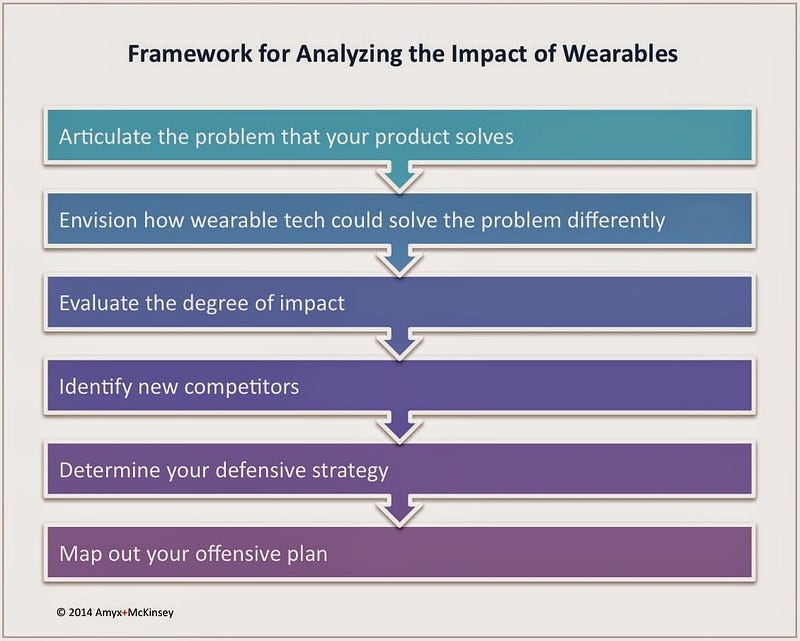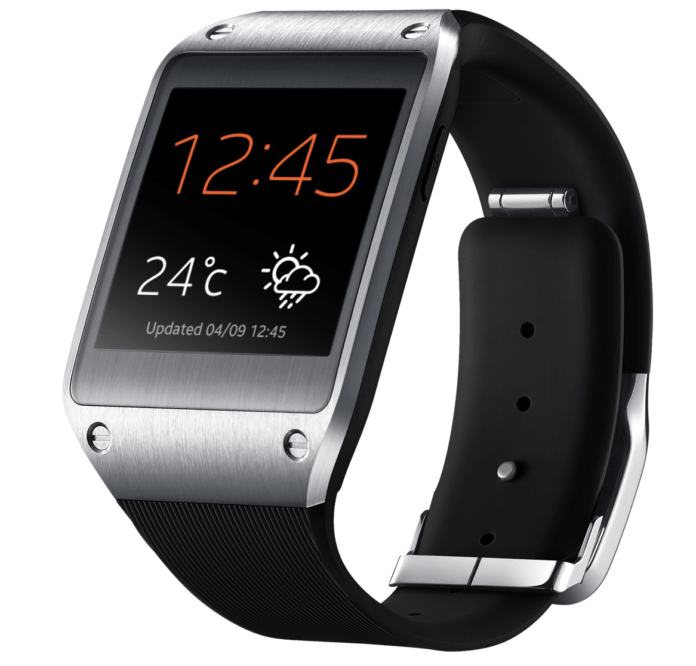Perhaps what comes first to your mind is the impact of wearables tech to the your BYOW (Bring Your Own Wearable) policy. This certainly warrants robust conversation but executives may be overlooking something even potentially bigger — the impact of wearables to their product strategy.
Have you begun to seriously ponder how wearables could change your current product line up? You may say we’re not in the fitness and health vertical; wearables don’t concern us. TomTom and Garmin, the once GPS giants, thought so too with smartphones. With the proliferation of GPS-enabled smartphones, they witnessed their core business erode away.
None of us have a crystal ball into the future but as a senior executive representing your organization, it’s imperative that you think through the potential implications to your product portfolio and service offerings. Sometimes the connection between wearable tech and your product strategy is not always straight-forward.
Often the issue isn’t that executives are unaware of the changing market landscape but rather overcoming the complacency of current market success. As we have seen with Dell, Blackberry, Motorola and other once marquee brands, today’s market leadership doesn’t guarantee tomorrow’s market dominance. It’s easy to excuse wearables as hype but then again, many laughed at the monetization model of cloud computing, the transformative power of enterprise mobility and the revolutionary impact of the Internet. Outgoing CEO Steve Baller admits his biggest mistake was overlooking mobile, for instance.
Some risk-averse executives are hesitant to explore new technologies unless they see their industry peers incorporate them into their product offering. For some, this market follower mindset creates a vicious cycle of scrambling to develop me-too solutions.
To stay ahead of the curve, executives need to stay engaged, which is different from having a pulse on the game. Practically that means staying engaged by experimenting and learning from those experiments. In the inchoate ecosystem of smart wearable tech, this can be challenging but certainly not impossible.
Amyx+ offers a framework to analyze the implication of wearables to your product strategy.

Articulate the Quintessential Problem Your Product Solves
It’s important to keep it in the simplest form. This helps to anchor the analysis to the problem that needs to be solved. Overtime, technologies will evolve but generally, the nature of the business problem remains intact, e.g., the business need for advertising, data security, workforce productivity, etc. Let’s take for example the need to transport products from one location to another. Overtime, new technologies have enabled faster and cheaper means of shipping goods. The Pony Express and sailing vessels were replaced by locomotives and engine-powered ships. Today, FedEx and UPS cargo planes and trucks deliver anywhere in the world within a day. In the future, Amazon plans to offer 30-minute delivery via autonomous helicopters called DRONE.
There are other instances where the nature of the problem evolves or becomes obsolete. The proverbial buggy whip case study in Economics textbooks is a great example. The buggy whip served a purpose in a horse-drawn carriage world. Once motorcars became ubiquitous, the need for buggy whips disappeared.
Envision How WearableTech Could Solve the Problem Differently
First develop a comprehensive matrix of wearable technologies & capabilities to get a lay of the landscape. Then envision how these capabilities could mature overtime to help you visualize the potential. For each wearable capability, evaluate how it could play a role in solving the business problem that you articulated earlier.
Let’s take Rosetta Stone (NYSE: RST) as an example. The problem that Rosetta Stone solves is learning a new foreign language. How could wearables potentially affect their product? (For the moment, we will set aside the shortcomings of language translation algorithms.) From the wearable capabilities matrix, let’s say that Rosetta Stone identified two categories that could potentially jeopardize the viability of their product offering, namely the smart glasses and earpiece categories.
Just take a look at Word Lens for Glass. It’s ostensible in the near-term a smart earpiece like Intel’s Jarvis could run a language translation app that can translate foreign spoken words into your native language audibly or transmit the translation to your smart glasses. How about a real-time dialogue? When you speak, your smart earpiece through jawbone conduction picks up your speech and then audibly translates out through a speaker built into your smart glasses.
Sure hardware makers and app developers have yet to fully explore such wearable use cases but it’s technically plausible in the near future. How does this possibility change the stated business problem of learning a new language? With such real-time audible translation capabilities, it reduces the need for people to invest months into learning a new language; demand for Rosetta Stone could decline overtime as a result.
Evaluate the Degree of Impact
Depending on your company’s vertical and product portfolio, the degree of the impact will vary. This will require a fine balance of critical thinking and creative envisioning to analyze potential vulnerabilities to your company or the identification of the next billion-dollar opportunity. The key is to eschew superficial analysis, dismissing wearables on the surface without fully understanding the dotted connections, two or more degrees away with the dimension of time that could catch your company by surprise.
Identify New Potential Competitors
What’s so fascinating about wearables is that it’s blurring traditional verticals. In a Wired article, Marcus Wohlsen made the case that Apple’s fiercest competitor in wearables is not Samsung or Google but Jawbone, the consumer audio startup. With wearables, competition is cropping up from surprising sectors, not within your immediate adjacent markets.
Michael Porter’s Five Forces provide a proven framework to analyze your changing landscape, competitive intensity, and attractiveness of a market, which can be applied to analyze the impact of smart wearables to your industry.
Determine Your Defensive Strategy
In the art of war, a sound defensive strategy goes hand-in-hand with your offensive strategy. Applying the methodology laid out this article should highlight salient deficiencies in your firm’s ability to adapt to rapidly changing market landscape. Take for instance, Apple has aggressively recruited high caliber talent from other disciplines to shore up their knowledge and experience gap in fashion, medical devices, and sleep research.
In more drastic cases, your defensive strategy may involve divestures as in the cases of Google’s sale of Motorola and IBM’s sale of low-end server unit to Lenovo. There’s no point in investing further into a dying business or a non-core product line.
Map Out Your Offensive Plan
A recent study from Booz & Company reported that Samsung spent $10.4 billion in 2013, coming in second in R&D spending. Samsung hasn’t been shy about their intention to lead innovation in the wearables space with the Samsung Galaxy S5 smartphone, Gear 2 smartwatch, and Gear Fit fitness band. According to Gartner’s Q4 2013 report on smartphone sales, Samsung led the pack with 29.5% market share. Samsung recognizes that market leadership hinges on the evolution of mobile computing to smart wearables. This is do-or-die commitment with hard dollars to back it up.
What’s the right game plan for your organization? A big, hairy, audacious, bet-the-company approach like Samsung or incremental investments overtime? It depends on the degree that wearables will impact your industry and your company. An insight that we can draw from the M&A playbook from Harvard Business Review is that M&A has a failure rate of 70% – 90% because the acquisition incorrectly aligned the strategic purpose of the deal — to improve current operations or to reinvent and transform the company’s growth prospects. The strategic misalignment points to the fact that most companies over-invest in the wrong things and under-invest in breakthrough technology that could accelerate the growth trajectory.
The key to any offensive plan is to stay engaged and to sharpen the saw so that your organization is prepared for the battle. Explore smart glasses app use cases. Research augmented reality technologies. Experiment with sensors. Competency and knowledge builds overtime. Staying on the sideline isn’t the same as being in the game. As you experiment, you will begin to see the next big opportunity crystallize. By then, you will be leaps and bounds ahead of the competition.
Products and companies don’t become obsolete overnight; they simply bleed to death, unable to reverse their downward spiral. This framework for analyzing the implication of wearable tech to your product strategy helps you to apply critical thinking to a nascent yet potential game changer. As a senior executive, you influence the growth curve of your organization. Smart wearables as an ecosystem represent a tectonic shift in every aspect. Prepare your company in the best way possible by experimenting now.
Originally published on Wired under the title of How Will Your Company Wear BYOW on March 27, 2014. Author Scott Amyx.


















